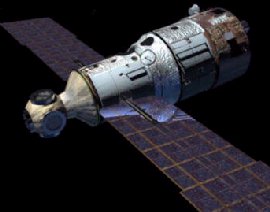Mir Modules - CORE

Updated July 6, 2000
Docking Module | Kristall | Kvant | Kvant-2 | Priroda | Progress-M | Soyuz-TM | Spektr
Mir Modules - CORE |
|
|
The central module of the MIR is the place where the areas of habitation of the station are installed (kitchen, area of personal hygiene and the " room " of the station).
The " room to be " has TV, music and videotape, as well as space for hundreds of tapes and books.
The kitchen of the station has a table, chairs, " stove " (electric resistance for the heating of food in individual portions) and trash bin. Two separate rooms, each one with bag to sleep (very comfortable in the space, therefore it does not have weight), table, mirror, and a small coolant with capacity for 40kg of food.
Each day, the cosmonauts spend about 3 to 4 hours in communications, 3 to 4 hours in system's maintenance and 5 hours in scientific research. Normally the team of cosmonauts has two people: a commander of flight (responsible mainly for the maintenance and walk through) and an engineer of flight ( activities of research and normally being the crew's doctor ).
The temperature of the station ranges the values of 18C and 29C; normally the temperature in the central module is of 23C.
Also in the central module there's the area of operation of the station, where it is possible to control and to monitor the diverse equipment, systems and experiments lead in the different modules. The control of the station is highly automated, only 13% of the relative operations of navigation and maintenance requires manual intervention. Despite this high level of automation, if the automatic control fails, the crew can manually lead 65% of the functions of the 23 main subsystems of the MIR.
The computational system of the station uses seven computers, linked all modules with digital data-bus, thus being able to monitor and to control all the systems and experiments. The prompt system is total automated and it does not spend fuel; There are 12 gyroscopes whose agreed action can change the position of the station to pick-up the biggest amount of solar energy possible.
For the coupling of the modules and the ships an automated system of prompt is used (KURS), that normally does not ask for manual intervention and in which the active element is the spacecraft to couple (ship SOYUZ or PROGRESS). The old system, used until 1990 (system IGLA), demanded that the entire station was guided towards the spacecraft that was passive during the approach to the MIR.
It is also in the central module that is the equipment of medical monitoring and physical exercises. The objective is to keep acceptable levels of physical and cardiovascular conditioning for the cosmonauts.
![]()